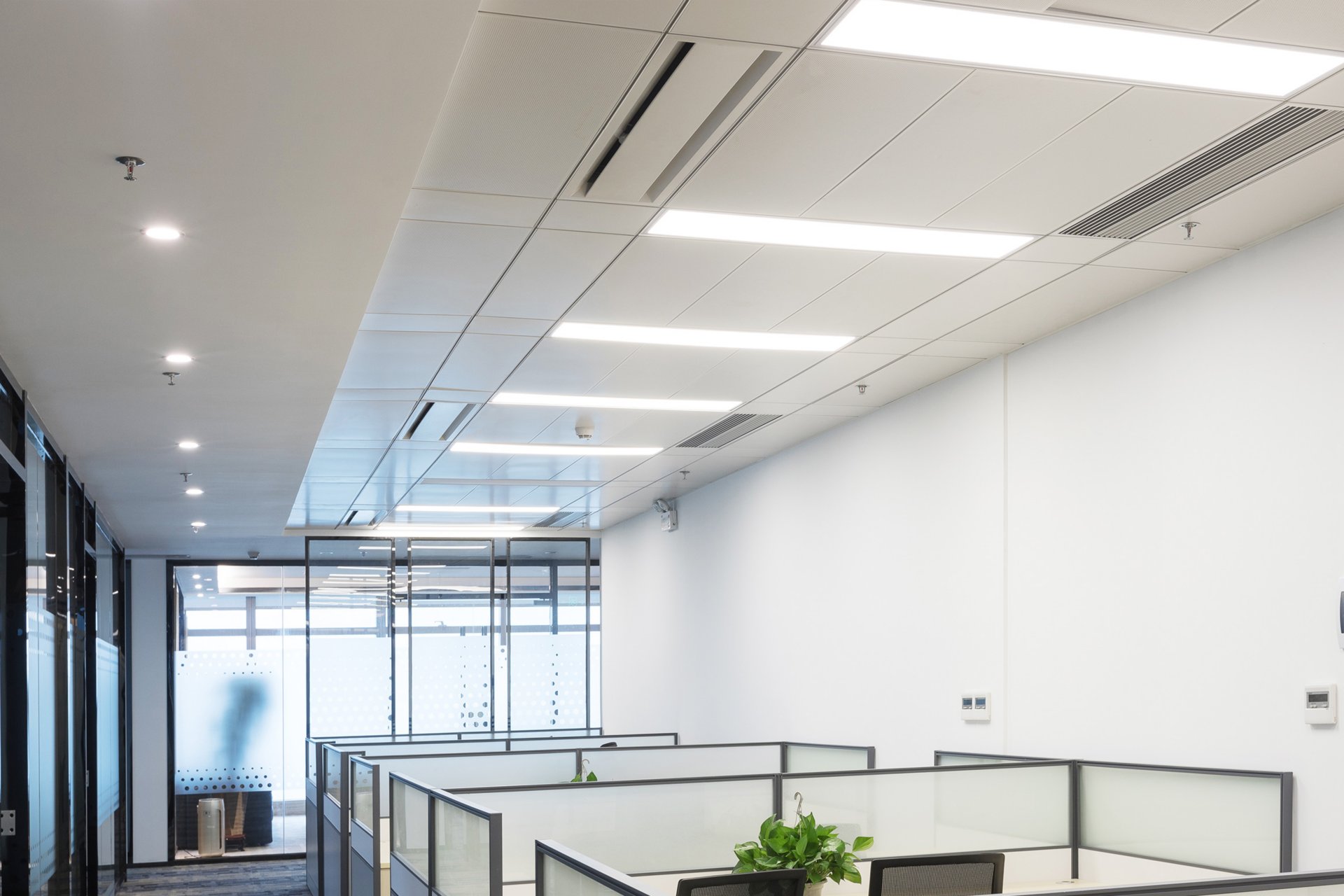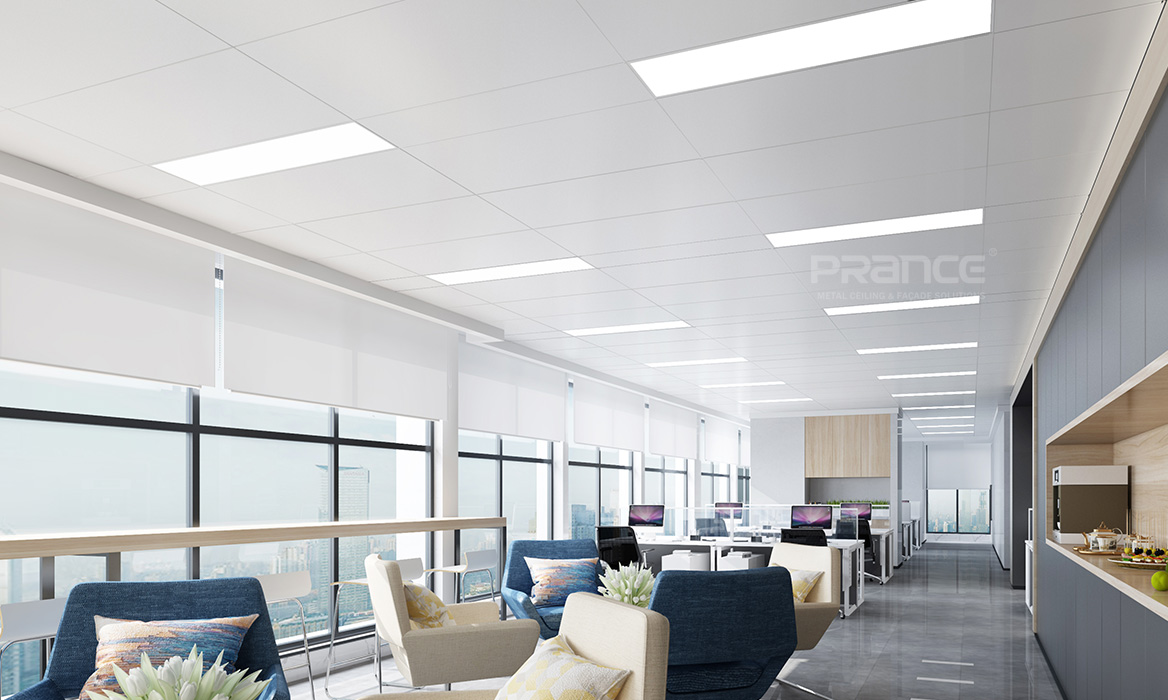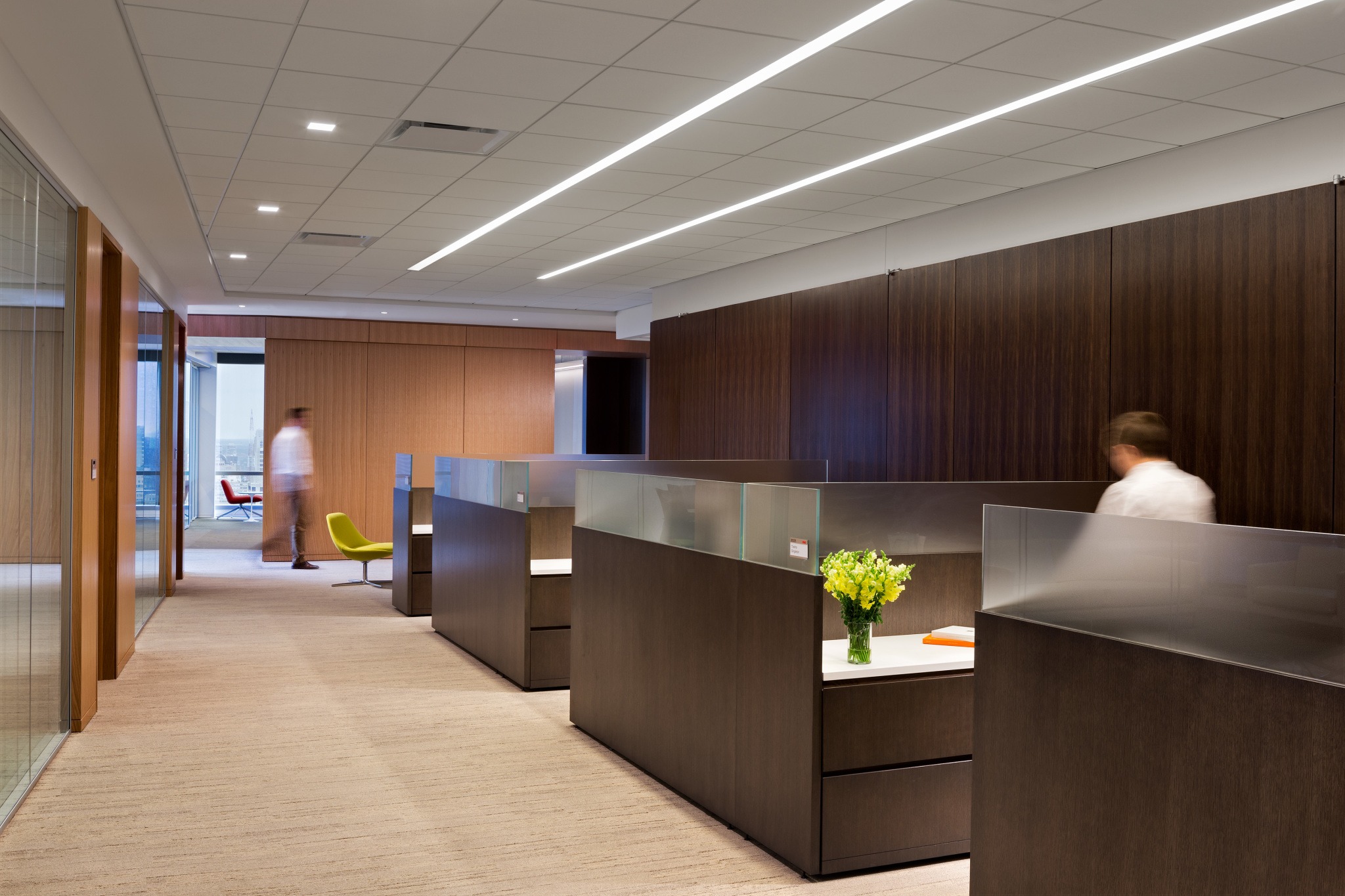PRANCE metalwork is a leading manufacturer of metal ceiling and facade systems.
Drop-in Ceiling Solutions for Modern Interiors
The process of building an aesthetically modern interior space needs purposeful design strategies. Drop-in ceiling solutions have increased in popularity among the various modern architectural choices. These ceilings combine versatility with functionality to turn spaces into contemporary zones while successfully managing acoustic requirements along with light and ventilation needs.
What Is a Drop-in Ceiling and How Does It Work?
A drop-in ceiling uses a support grid to hold its ceiling tiles or individual panels in position. These tiles are installed beneath the main structural ceiling to provide a second-level covering that conceals sharp wires as well as heating vents and additional unwanted components of the room's infrastructure. Drop in ceilings remain the preferred option for residential together with commercial premises.
Key Features of Drop-in Ceilings in Interior Design

Drop in ceilings feature these significant elements for interior designs.
- Versatile Design: Drop-in ceilings maintain versatility through their multiple material options together with diversified design patterns, so they suit all kinds of interior aesthetics.
- Accessibility: The modular concept allows maintenance teams to reach hidden utilities by providing easy access.
- Cost-Effective: They offer accessible costs alongside trouble-free installation when compared to standard ceiling installations.
- Improved Acoustics: These audio-friendly tiles help create ceilings that are perfect for office and educational environments and domestic spaces.
Top Benefits of Drop-in Ceilings in Modern Interiors
Drop-in ceiling solutions present measurable benefits for contemporary interior designs. Modern interior decor seeks functional solutions without sacrificing aesthetics, and drop-in ceiling systems provide a unified approach to balance design and utility. Installing a drop-in ceiling allows improved lighting efficiency and visual appeal while controlling noise levels in occupied spaces.
1. Aesthetic Appeal: Enhancing Interior Visuals
Drop-in ceilings combine adjustable designs and neat linear structures, which provide boundless design freedoms for homeowners.
- Design Variety: Every design idea finds its perfect match through ceiling designs that suit your specific preferences, from modern minimalist to decorative bold statements. Wood and metallic coatings and patterned tiles represent common choices in drop-in ceiling designs.
- Lighting Optimization: Reflective panels with LR values of 0.6–0.85 enhance ambient illumination and support energy-efficient lighting.
- Material Standards: Many drop-in ceiling materials meet CE or ASTM durability standards, ensuring long-term performance without aesthetic compromise.
- Spatial Harmony: Modular layouts and neat linear structures allow ceilings to seamlessly integrate with walls, lighting, and HVAC elements.
2. Functional Performance: Lighting, Acoustics, and Efficiency
The architecture benefits from drop-in ceilings, which solve both appearance-related requirements and utility challenges. These designs enable the integration of built lights while reducing noise transmission through insulation, which creates a thermal envelope.
- Lighting Integration: Drop-in ceiling panels can accommodate recessed or LED fixtures, enhancing uniform light distribution. Properly reflective panels can improve ambient brightness by 10–15%, reducing artificial lighting demand.
- Acoustic Performance: Acoustic-backed drop-in ceiling tiles can achieve a Noise Reduction Coefficient (NRC) of 0.7–0.85, reducing echo in offices, classrooms, and residential interiors.
- Thermal Efficiency: When paired with insulated tiles or plenum materials, drop-in ceilings can contribute to an R-value increase of 1.5–2.5, supporting HVAC energy savings of up to 10–12% annually.
- Maintenance Accessibility: Modular drop-in ceiling designs allow individual panels to be removed for inspection or repair, reducing downtime by 30–50% compared to traditional fixed ceilings.
Common Drop Ceiling Materials and Their Key Advantages
1. Gypsum: Lightweight and Fire-Resistant
The weight-saving properties of gypsum tiles lead to cost-effective solutions that deliver superior fire protection. You can find it commonly used in homes and small office spaces; these tiles often meet ASTM E119 fire-resistance standards, ensuring safety while maintaining lightness for easy installation.
2. Metal: Durable and Moisture-Resistant
Metal ceiling tiles created from aluminium or steel deliver an industrial appearance with a sleek appearance. Coated with PVDF or powder finishes, metal tiles resist moisture, making them ideal for bathrooms and kitchens. Their reflective surfaces can enhance ambient lighting by up to 15%, improving energy efficiency.
3. Mineral Fiber: Acoustic Performance
Mineral fiber tiles are widely used for their sound absorption properties. With a typical Noise Reduction Coefficient (NRC) of 0.6–0.85, they effectively reduce echoes in offices, schools, and commercial spaces, creating a quieter and more comfortable environment.
4. PVC: Water-Resistant and Easy to Maintain
PVC tiles combine high water resistance with simple cleaning requirements, making them ideal for spaces with high moisture levels such as bathrooms and basements. Their durable, non-porous surfaces reduce long-term maintenance needs.
How to Choose the Right Drop Ceiling Material
| Environment / Need | Recommended Material | Key Benefit | Notable Feature |
|---|---|---|---|
| High humidity (bathrooms, kitchens, basements) | Metal / PVC | Excellent moisture and corrosion resistance | Long lifespan, minimal maintenance |
| Noise control (offices, classrooms) | Mineral Fiber | Superior sound absorption (NRC 0.6–0.85) | Improves speech clarity and comfort |
| Fire safety and cost efficiency (homes, small offices) | Gypsum | Lightweight, fire-rated, affordable | Meets ASTM E119 fire-resistance standards |
| Sleek modern interiors (commercial, retail) | Aluminum | Contemporary look, durable, reflective surface | Enhances lighting efficiency by up to 15% |
Drop-in Ceiling Installation Process: Step-by-Step Guide
A drop-in ceiling system needs a structured installation method to achieve a perfect outcome. The process includes:
1. Planning and Measurements
Dimensional accuracy measurements followed by grid layout design constitute the initial procedures. Measuring the ceiling area precisely—typically within ±3 mm tolerance—ensures tiles fit properly and create symmetrical lines across the space.
Pro Tip: Always mark reference lines using a laser level to maintain even height alignment across the room, especially in large commercial spaces exceeding 30 m².
2. Installing the Grid System
Drop-in ceiling systems use lightweight metal grids (commonly galvanized steel or aluminum) that hang from the structural ceiling by suspension wires spaced every 1.2 m to 1.5 m. This ensures the framework maintains load stability and prevents sagging over time.
Pro Tip: Follow ASTM C635/C636 standards for grid spacing and hanger wire gauge to ensure structural reliability and ease of future maintenance.
3. Placing the Tiles
After the grids reach their installation stage bubbles get arranged properly into their designated slots. All components occupy slots in the framework, which makes them easy to access without affecting the final appearance or functionality of the ceiling system.
See How It's Done: Watch our step-by-step animation to learn how a drop-in ceiling is planned, installed, and finished with professional precision.
Where to Use Drop-in Ceilings: Best Applications

Drop-in ceilings are suitable for various settings, each benefiting from their unique features:
1. Residential Spaces
Drop-in ceilings become popular residential installation solutions within basements and kitchens, and they find application in living rooms, too. The tiles both conceal architectural flaws and create an elegant appearance.
2. Commercial Spaces
You will discover drop-in ceilings commonly installed throughout offices together with retail stores and restaurants because of their dual acoustic and aesthetic advantages. These ceiling fixtures enable easy mounting for both lighting and HVAC infrastructure.
3. Educational Institutions
School buildings and college institutions utilize drop-in ceilings because these acoustic solutions do better at reducing noise while building a better learning space.
Professional Maintenance Tips for Drop-in Ceilings
To keep your drop-in ceiling performing and looking its best, follow these professional maintenance practices recommended by industry specialists.
1. Regular Cleaning
Regular dust and dirt accumulation can reduce the reflectivity and lifespan of tiles over time. Schedule cleaning every 3–6 months using a soft cloth or vacuum with a brush attachment. For metal or PVC tiles, a mild detergent solution (pH 6–8) can be used to remove surface stains without damaging coatings. Avoid high-pressure cleaning or abrasive materials.
2. Inspect for Damage
Perform a visual inspection at least twice a year to identify cracked tiles, corrosion, sagging, or joint gaps. Damaged panels can compromise fire ratings or acoustic performance. Replace any affected tiles immediately and ensure suspension wires are tensioned correctly to maintain grid alignment.
3. Address Stains Quickly
Water leakage often causes stains that can lead to structural damage if ignored. Identify and repair the leak source before replacing any stained panels. For persistent moisture issues, consider upgrading to moisture-resistant drop-in ceiling materials, such as aluminum to extend service life.
2025 Trends in Drop-in Ceiling Design and Innovation

Sustainable Materials
Smart Integration
3D Textures
FAQs
1. How to install a drop ceiling in a basement?
To install a drop ceiling in a basement, measure the space, mark your grid layout, and secure suspension wires to the joists. Attach the main runners and cross tees to form a grid, then place the drop-in ceiling tiles. Choose moisture-resistant tiles to prevent mold and maintain a clean look in humid basement environments.
2. What are the benefits of drop in ceiling tiles for commercial use?
Drop in ceiling tiles improve acoustics, conceal wiring, and create easy access for maintenance. They’re available in various materials like metal, PVC, or mineral fiber, allowing you to balance appearance, durability, and budget while maintaining professional aesthetics in offices or retail spaces.
3. What size are drop in ceiling tile 2x4 panels typically used for?
Drop in ceiling tile 2x4 panels are standard for most commercial buildings because they cover larger areas with fewer joints. Their modular size simplifies installation and replacement, providing a smooth ceiling surface while supporting integrated lighting or HVAC systems for better performance.
4. How can I add drop in ceiling lights effectively?
Drop in ceiling lights can be integrated into the ceiling grid by replacing a tile with a compatible LED panel or recessed fixture. Ensure proper weight support and wiring clearance above the grid. Using reflective ceiling tiles around the lights enhances brightness and energy efficiency.
5. What materials are best for a drop in ceiling grid system?
A drop in ceiling grid system typically uses galvanized steel or aluminum for stability and corrosion resistance. Aluminum grids are lightweight and easy to cut, while steel provides superior strength for heavy tile installations, ensuring long-term durability in commercial or high-humidity environments.




















